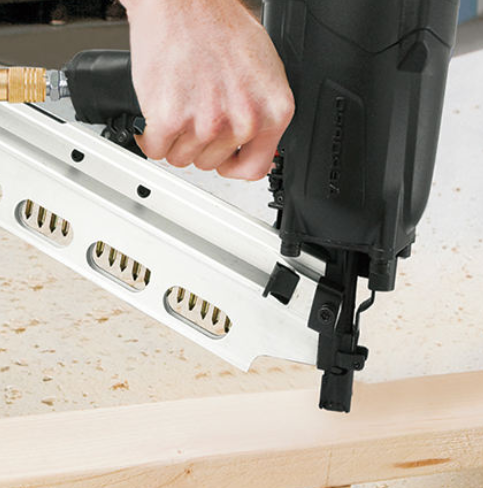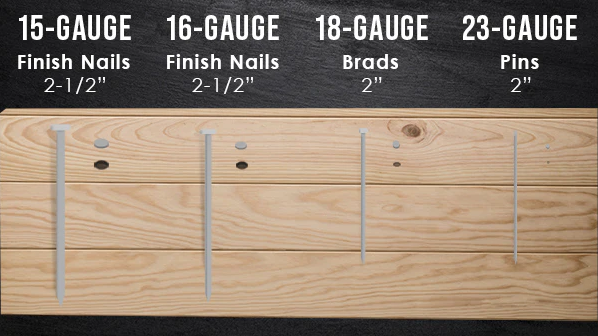
When you need to pick the right nail for finish work, some people always ask: What kind of nails should I use for my air nailer? Choosing the right nails is an important part of any woodworking or construction project.
First and foremost, it's important to understand the gauge of a nail. The most common gauges used in nail guns are 15, 16, 18, and 23. The lower the gauge number, the more versatile the nail becomes, as it can be used in a variety of applications.
A nail's gauge refers to its diameter or thickness, the gauge refers to the thickness of the nail, with a higher gauge number indicating a thinner nail, and it plays a crucial role in the strength and holding power of the nail. Nail gauges are inversely proportioned. For instance, a 16-gauge nail is thicker than an 18-gauge one.
15 & 16-Gauge finish nails. These nails are very similar and offer great holding power. It may be a little more difficult to conceal the hole after its nailed into place, but its not impossible. This is a good range to be in for finish carpentry jobs like cabinets, paneling, and crown molding.15-gauge nails are the thickest and are typically used for heavy-duty projects such as framing, decking, and fencing. They have a large diameter and a coarse thread, making them ideal for thicker materials like 2x4s and 2x6s. They also provide a stronger hold, which is essential when working with heavy materials. 16-gauge nails are the next step down in thickness and are suitable for a wide range of applications, including framing, sheathing, and siding. They have a slightly smaller diameter than 15-gauge nails and a finer thread, making them ideal for working with thinner materials like plywood and OSB. They also provide a good balance between holding power and ease of use.
18-Gauge brad nails are even thinner and are commonly used for finish work, such as trim, molding, and furniture. They have a small diameter and a very fine thread, making them perfect for working with delicate materials like wood trim and molding. These fasteners are smaller in diameter when comparing it to the 15 and 16-gauge, which makes the holding power a little weaker. However, this gauge can be extremely useful for woodworking projects as you can easily cover it with a filler.
23-Gauge pin nails are the thinnest and are typically used for very delicate work, such as upholstery, crafting, and small wood projects. They have an extremely small diameter and a very fine thread, making them ideal for working with very thin materials like fabric and plastic. They also provide a minimal hold, which is essential when working with materials that require a gentle touch.

So common gauges for nails include 15, 16, and 18, each suitable for different applications. A 15 or 16-gauge nail is ideal for heavy-duty projects like framing or deck building, where strength and holding power are paramount. On the other hand, an 18-gauge brad nail is perfect for delicate tasks like attaching trim, molding or for stapler, where you want minimal splitting and a small nail hole. lower gauge nails are stronger and used for heavier projects like framing, while higher gauge nails are less sturdy and suited for lighter work like attaching trim or delicate molding. Such as, you can also find thinner gauge nails ranging from 20 to 22 gauge. U-shaped nails, also known as staples, these have a U-shape with two legs for fastening. They are used for construction, upholstery and furniture. Common leg lengths are 1/2", 5/8''.
Match nail length to the thickness of the material being fastened. You want sufficient holding power but don't want the nail tip poking through the other side. As a rule of thumb: For framing lumber or other thick material, choose a nail length about 2.5x the thickness. So for a 2x4 stud, use a nail around 3 inches or 7d. For thinner material like plywood sheathing, size the nail so it penetrates at least 1 inch into the support behind.
When nailing into a stud through drywall, go with nails at least 1.5 inches longer than the drywall thickness to bite into the stud. Nail head style is another consideration. Common options include: Flat head is a flat, low profile head. The most common for framing. Round head is a small rounded head. Used for finish nailing. Brad nails are headless nails designed to be sunk flush into the wood. Convenient for delicate trim work. Roofing nails Broad, flat heads to maximize hold in roof sheathing. Masonry or concrete nails, hardened with spiral shafts and specialized heads to penetrate concrete and brick.

AEROPRO offers air nailers suitable for every nailing work, from framing, finishing or roofing work, that can be adapted to a wide range of nails. With AEROPRO's range of nailers in your toolbox, you'll have a fastener driving solution for any woodworking or construction project.
Finally, make sure your nails are compatible with your air nailer tool. Consult your AERORPO tool manual for the right type and size of fastener.
View More About AEROPRO Air Nailer Series.
If you need product quotation service, please contact: sales@aeroprotools.com